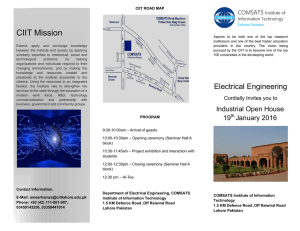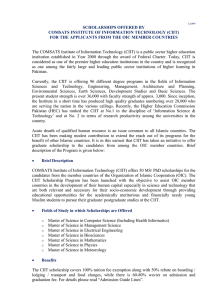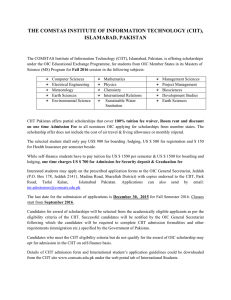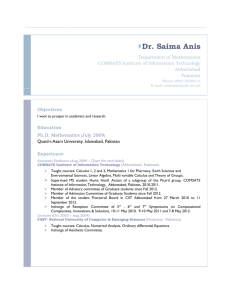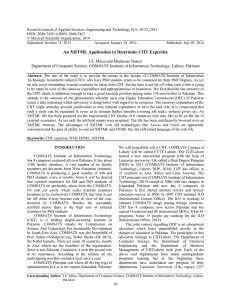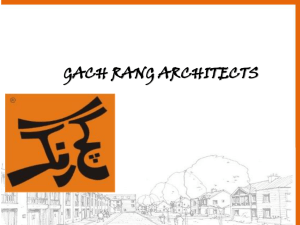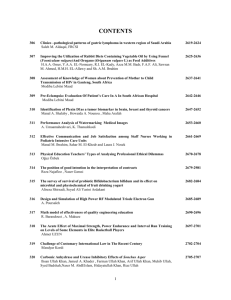Objective: My basic aim is to learn, explore and implement novel
advertisement
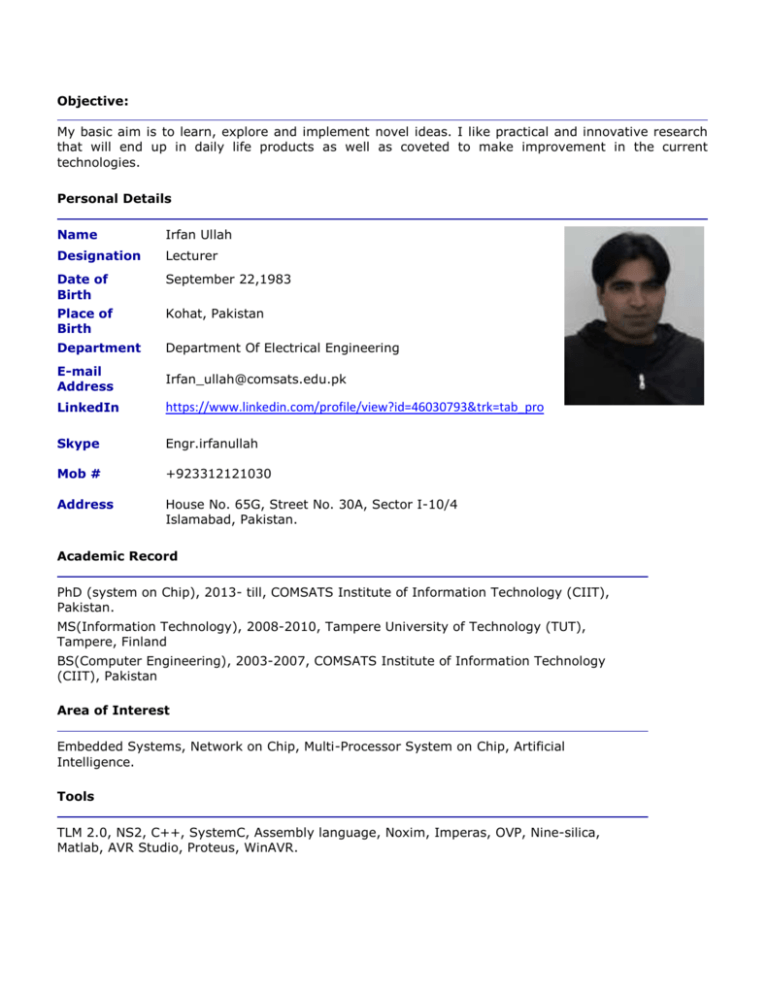
Objective: My basic aim is to learn, explore and implement novel ideas. I like practical and innovative research that will end up in daily life products as well as coveted to make improvement in the current technologies. Personal Details Name Irfan Ullah Designation Lecturer Date of Birth September 22,1983 Place of Birth Kohat, Pakistan Department Department Of Electrical Engineering E-mail Address Irfan_ullah@comsats.edu.pk LinkedIn https://www.linkedin.com/profile/view?id=46030793&trk=tab_pro Skype Engr.irfanullah Mob # +923312121030 Address House No. 65G, Street No. 30A, Sector I-10/4 Islamabad, Pakistan. Academic Record PhD (system on Chip), 2013- till, COMSATS Institute of Information Technology (CIIT), Pakistan. MS(Information Technology), 2008-2010, Tampere University of Technology (TUT), Tampere, Finland BS(Computer Engineering), 2003-2007, COMSATS Institute of Information Technology (CIIT), Pakistan Area of Interest Embedded Systems, Network on Chip, Multi-Processor System on Chip, Artificial Intelligence. Tools TLM 2.0, NS2, C++, SystemC, Assembly language, Noxim, Imperas, OVP, Nine-silica, Matlab, AVR Studio, Proteus, WinAVR. Experience Lecturer at Electrical Engineering Department, CIIT, Islamabad, Pakistan (September 2010 – Present) Teaching undergraduate courses and supervising undergraduate projects. Also have to perform some additional administrative responsibilities. Research Associate at Electrical Engineering Department, TUT, Finland (February 2009 – August 2010) Worked on the sysmodel project. The SYSMODEL project aims at providing SMEs with system level modeling tools for the design and implementation of time and power critical, heterogeneous systems. It allows the SMEs to build cost-efficient ambient intelligence systems with optimal performance, high confidence, reduced time to market and faster deployment. I developed a System Level cycle accurate model of Hierarchical Network-on-Chip (NoC) for on-Chip Multi-Core Platform using SystemC. http://www.sysmodel.eu/ Research Associate at Electrical Engineering Department, CIIT, Islamabad, Pakistan (August 2007 – August 2008) Beam forming is a signal processing technique used with arrays of transmitting or receiving transducers that control the directionality of, or sensitivity to, a radiation pattern. When receiving a signal, beam forming can increase the receiver sensitivity in the direction of wanted signals and decrease the sensitivity in the direction of interference and noise. We used this technique for the array of microphones to detect and remove Gaussian Noise. At the same time responsible for teaching some undergraduate courses and Lab work. Administrative Posts/Duties Member Thesis management committee. Member Final Exams Enter Departmental Vigilance Committee 2013 CIIT. Member of Organizer Committee Enter Departmental Sport week CIIT. CEPEX 2011 Organizer Committee CIIT. Class Counselor for undergraduate Students. Member of Pak-China Business Forum Organizer Committee 2012. In-charge Computer Engineering Department 2012. Member of Organizing Committee International Symposium on System-on-Chip 2009,Tampere,Finland Thesis MS Dissertation: System Level Model of Hierarchical Network-on-Chip for System-Level on-Chip Multi-Core Platforms. The system level NoC Cycle accurate model is able to simulate the communication network with several number of nodes and data packets. The modeled NoC is able to give useful information regarding to delay, virtual channels and number of clock cycles required to transfer the data packets. The user can also be able to get information about the position of any data packet at any clock cycle in the network during simulation. http://dspace.cc.tut.fi/dpub/bitstream/handle/123456789/6778/ullah.pdf?sequence=3 BS Thesis: Real Time Mobile Robot with Analysis of Surrounding Environment and High Speed Integrated Embedded Wireless Communication System. The aim of the project is to create an autonomous mobile robot, that will able to explore the unknown terrain/environment. It is a moving robot equipped with wireless transmission unit and also having some sensors. Sensors can help the robot in movement and also in collecting real time data from surrounding environment Collected data or information will be wirelessly transmitted to computer and also displayed on Liquid crystal display (LCD) fixed on the mobile robot. Computer can receive data from serial port and display it in Graphic User Interface (GUI).GUI was implemented in Visual Basic 6.0. .Additionally, The robot is also able to follow the map with the help of GUI installed in Computer. Internships: 1. Worked at Communication Department at OGDCL, Islamabad 2. Worked as a Teacher Assistant of System Programming at COMSATS University. Other Undergrad Projects • Remote kit for computer, Controlling the computer wirelessly through IR with the help of IR remote and receiver using VB (4th prize in all Pakistan Electronic Exhibition UET Lahore 2005) Operating system used Windows XP. • Lab after hour Computation, Using socket based Client/Server architecture make a cluster of computers and the job is equally divided among the clients. Clients execute the part of their job automatically and send result back to server. Operating system used Linux. Language Used C. • Software based Cricket Score Board, Programmed in C++ • Semi-autonomous Electronic Switch board for Electrical Appliances, 89C51 Micro-controller programmed in Assembly, IR sensors, LCD and relays. Undergrad Projects Supervised o o Implementation of IVR Based Calculator for Blind o o Vehicle Tracking System (Collaboration with AH Automation) o o An Improved Multi-layered Vehicle Security System February 2011 to June 2012 COMSATS institute of Information Technology Team Members: Irfan Ullah, Rao Salman, Shaif Iqbal khan, Asif February 2011 to July 2012 COMSATS institute of Information Technology Team Members: Irfan Ullah, Hassan Khan, M. Hamid Ashraf, Sikander ali February 2011 to June 2012 COMSATS institute of Information Technology Team Members: Irfan Ullah, Usman Ali, Alveena Israr, Qasim Ayaz Qazi o o Wireless Based Remote Patient Monitoring System March 2012 to March 2013 COMSATS institute of Information Technology Team Members: Irfan Ullah, Zohaib Najam, Masood Ahmed, Mohammad Dawood Courses Taught AutoCAD(Fall 2007,Spring 2008) Electric Circuit Analysis(Fall 2010, Spring 2011) Electronic(Fall 2011) Microprocessor Systems and Interfacing (Spring 2012,Fall 2012) Computer Architecture, Microprocessor Systems and Interfacing (Spring 2013) References 1. Prof. Dr. Jari Nurmi, Tampere University of Technology, Finland (jari.nurmi@tut.fi) 2. Assistant Prof. Dr. Zeeshan Ali Khan, COMSATS Institute of Technology, Pakistan (zakhan@ciit.edu.pk)
